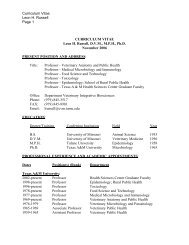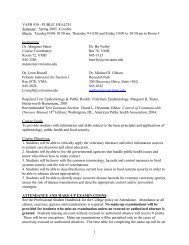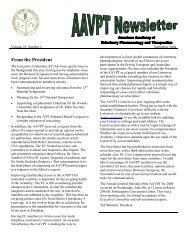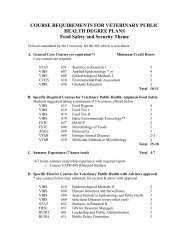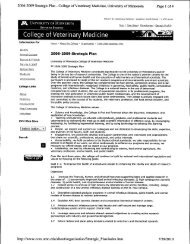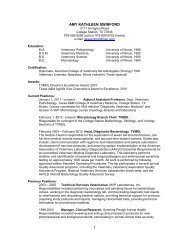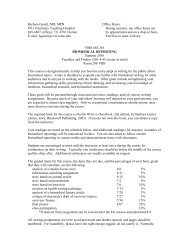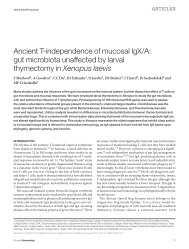Updates in canine hip replacement - College of Veterinary Medicine ...
Updates in canine hip replacement - College of Veterinary Medicine ...
Updates in canine hip replacement - College of Veterinary Medicine ...
You also want an ePaper? Increase the reach of your titles
YUMPU automatically turns print PDFs into web optimized ePapers that Google loves.
Vol. 1, No. 1 ~ Fall 2010<br />
Buzz DeCola, a <strong>hip</strong> <strong>replacement</strong><br />
patient at the Small Animal Hospital.<br />
Can<strong>in</strong>e <strong>hip</strong> <strong>replacement</strong><br />
factoids...<br />
• Until recently, total <strong>hip</strong> <strong>replacement</strong><br />
(THR) was typically reserved<br />
for mature, large or giant<br />
breed dogs with severe osteoarthritis<br />
<strong>of</strong> the <strong>hip</strong><br />
• An updated THR system is now<br />
available that uses a “press fit”,<br />
which allows bone <strong>in</strong>growth <strong>in</strong>to<br />
the components, elim<strong>in</strong>at<strong>in</strong>g the<br />
need for bone cement<br />
• This biological fixation system<br />
(BFX) allows THRs to be performed<br />
<strong>in</strong> younger dogs (even<br />
10-12 months) and has many advantages<br />
over other systems<br />
• We also have THR implants for<br />
use <strong>in</strong> small breed dogs and cats<br />
a quarterly publication <strong>of</strong> the small animal surgery service at<br />
the Texas A&M University Veter<strong>in</strong>ary Medical Teach<strong>in</strong>g Hospital<br />
surgery<br />
Total <strong>hip</strong> <strong>replacement</strong> (THR) is the<br />
only procedure that completely elimi-<br />
nates pa<strong>in</strong> while restor<strong>in</strong>g full-function to<br />
a diseased <strong>hip</strong> jo<strong>in</strong>t. As such, it is the pre-<br />
ferred surgical treatment for a number <strong>of</strong><br />
conditions such as <strong>hip</strong> dysplasia, <strong>hip</strong> luxa-<br />
tions, and <strong>in</strong>tra-articular fractures.<br />
Total <strong>hip</strong> <strong>replacement</strong> (THR) has been<br />
performed on client-owned dogs s<strong>in</strong>ce<br />
the 1970’s. Initial <strong>hip</strong> <strong>replacement</strong> systems<br />
mimicked those used <strong>in</strong> humans, and re-<br />
quired the use <strong>of</strong> medical grade bone<br />
cement (PMMA) to secure both the ac-<br />
etabular and femoral implants <strong>in</strong> proper<br />
position. Over the next several decades,<br />
advances <strong>in</strong> implant design and cement-<br />
<strong>in</strong>g techniques resulted <strong>in</strong> newer “genera-<br />
tions” <strong>of</strong> THR systems.<br />
The newest cemented THR system<br />
is manufactured by Biomedtrix (www.<br />
biomedtrix.com) and is known as the CFX®<br />
system. Results with the CFX system are<br />
excellent; 90-95% <strong>of</strong> can<strong>in</strong>e patients<br />
have resolution <strong>of</strong> lameness, full return<br />
to function, and no long-term complica-<br />
tions. However, some <strong>in</strong>herent risks exist<br />
with the use <strong>of</strong> bone cement, <strong>in</strong>clud<strong>in</strong>g<br />
implant <strong>in</strong>fection and aseptic loosen<strong>in</strong>g,<br />
a process <strong>in</strong> which the cement-bone <strong>in</strong>ter-<br />
VETERINARY MEDICINE<br />
& BIOMEDICAL SCIENCES<br />
NOTES<br />
<strong>Updates</strong> <strong>in</strong> can<strong>in</strong>e <strong>hip</strong> <strong>replacement</strong><br />
Did you know?<br />
VD radiograph <strong>of</strong> dog with severe <strong>hip</strong><br />
dysplasia<br />
face is slowly destroyed result<strong>in</strong>g <strong>in</strong> failure<br />
<strong>of</strong> the THR. These same risks also occur<br />
<strong>in</strong> human cemented THRs. For this rea-<br />
son, THR systems were developed to elim-<br />
<strong>in</strong>ate the use <strong>of</strong> bone cement.<br />
Cementless implants are <strong>of</strong> larger size<br />
and have a porous titanium coat<strong>in</strong>g which<br />
allows the patient’s bone to grow <strong>in</strong>to the<br />
implants after surgery. A cementless THR<br />
system was used by veter<strong>in</strong>ary surgeons <strong>in</strong><br />
There are currently three <strong>hip</strong> <strong>replacement</strong> systems available for veter<strong>in</strong>ary use. The<br />
Biomedtrix system has been used <strong>in</strong> over 50,000 cases, and is the only system that allows<br />
placement <strong>of</strong> cementless or cemented implants. This unsurpassed versatility is one <strong>of</strong><br />
the reasons why we perform Biomedtrix total <strong>hip</strong> <strong>replacement</strong>s.
the 80’s and 90’s at North Carol<strong>in</strong>a State<br />
University and results were extremely<br />
encourag<strong>in</strong>g.<br />
Biomedtrix has developed and re-<br />
leased an updated cementless <strong>hip</strong> re-<br />
placement system based on the NCSU<br />
design. The Biomedtrix BFX® <strong>hip</strong> has<br />
been <strong>in</strong> use s<strong>in</strong>ce 2004, and is the system<br />
<strong>of</strong> choice for many <strong>hip</strong> <strong>replacement</strong> sur-<br />
geons. Similar to the CFX <strong>hip</strong>, cl<strong>in</strong>ical<br />
results with the BFX <strong>hip</strong> appear to be<br />
outstand<strong>in</strong>g, with 90–95% <strong>of</strong> dogs hav-<br />
<strong>in</strong>g excellent outcomes. It also appears<br />
that the <strong>in</strong>cidence <strong>of</strong> aseptic loosen<strong>in</strong>g<br />
may be decreased when compared with<br />
cemented systems.<br />
One advantage <strong>of</strong> the Biomedtrix sys-<br />
tem is the universal surgical technique<br />
that is used. A s<strong>in</strong>gle surgical technique<br />
allows surgeons to use either CFX or<br />
BFX components <strong>in</strong> their patients. Al-<br />
though it is ideal to use BFX implants <strong>in</strong><br />
every case, some dogs are not good can-<br />
didates for BFX implants due to bone<br />
shape and bone quality. The Biomed-<br />
trix system allows “hybridization” <strong>of</strong> im-<br />
plants for these dogs, which is the com-<br />
b<strong>in</strong>ation <strong>of</strong> BFX or CFX components.<br />
Not only does Biomedtrix produce<br />
the lead<strong>in</strong>g THR system, but they have<br />
also developed smaller implants for use<br />
<strong>in</strong> small breed dogs and cats! Indica-<br />
tions for THR <strong>in</strong> these patients <strong>in</strong>clude<br />
treatment <strong>of</strong> <strong>hip</strong> dysplasia, Perthes’ dis-<br />
ease, <strong>hip</strong> luxations, and fractures <strong>in</strong>volv-<br />
Faculty Spotlight: Dr. Brian Saunders<br />
Dr. Brian Saunders is a 2001 graduate <strong>of</strong><br />
the Texas A&M University <strong>College</strong> <strong>of</strong> Veteri-<br />
nary Medic<strong>in</strong>e & Biomedical Sciences (DVM)<br />
and a 2005 graduate <strong>of</strong> Texas A&M University<br />
Health Science Center (PhD). After comple-<br />
tion <strong>of</strong> a small animal surgical residency,<br />
he jo<strong>in</strong>ed the faculty as a Cl<strong>in</strong>ical Assistant<br />
Pr<strong>of</strong>essor <strong>in</strong> Orthopedic Surgery <strong>in</strong> 2009.<br />
Radiographs <strong>of</strong> a dog before and after BFX<br />
total <strong>hip</strong> <strong>replacement</strong>.<br />
Left: Biomedtrix® BFX implants;<br />
Right: Biomedtrix® CFX implants<br />
Dr. Saunders cl<strong>in</strong>ical <strong>in</strong>terests <strong>in</strong>clude jo<strong>in</strong>t<br />
<strong>replacement</strong>, arthroscopy, and m<strong>in</strong>imally <strong>in</strong>-<br />
vasive fracture repair. He also has a strong<br />
research <strong>in</strong>terest, and is <strong>in</strong> the process <strong>of</strong> es-<br />
tablish<strong>in</strong>g a cell biology laboratory to <strong>in</strong>vesti-<br />
gate the molecular aspects <strong>of</strong> common ortho-<br />
pedic conditions.<br />
<strong>in</strong>g the <strong>hip</strong> jo<strong>in</strong>t. With the arrival <strong>of</strong> the<br />
microTHR, surgeons can now provide<br />
patients with pa<strong>in</strong>-free, normal func-<br />
tion regardless <strong>of</strong> their size.<br />
Why should you<br />
consider referr<strong>in</strong>g<br />
your <strong>hip</strong> dysplasia<br />
cases to Texas A&M?<br />
Texas A&M or-<br />
thopedic surgeons<br />
use the Biomedtrix THR systems. We<br />
have been perform<strong>in</strong>g THRs s<strong>in</strong>ce the<br />
1980’s, and our faculty have a wealth <strong>of</strong><br />
experience with the procedure. We have<br />
a passion for <strong>hip</strong> <strong>replacement</strong> surgery,<br />
and are committed to the highest level<br />
<strong>of</strong> surgical, peri-operative, and post-<br />
operative care. We realize that cost is<br />
<strong>of</strong> central importance for most clients<br />
consider<strong>in</strong>g THR for their pet; pric<strong>in</strong>g<br />
at Texas A&M is extremely competitive.<br />
Although Texas A&M is a teach<strong>in</strong>g<br />
hospital, success with THR is directly<br />
related to surgical experience. As such,<br />
all THRs are performed exclusively<br />
by ACVS Diplomates. F<strong>in</strong>ally, cases<br />
referred to Texas A&M for THR are<br />
screened meticulously before surgery,<br />
and a prolonged consultation occurs<br />
between the THR surgeon and client.<br />
Medical and surgical treatment options<br />
are covered, as well as specific surgical<br />
options for their pet.<br />
Visit the VMTH Small Animal Surgery Service on the web at vetmed.tamu.edu/services/orthopedics




